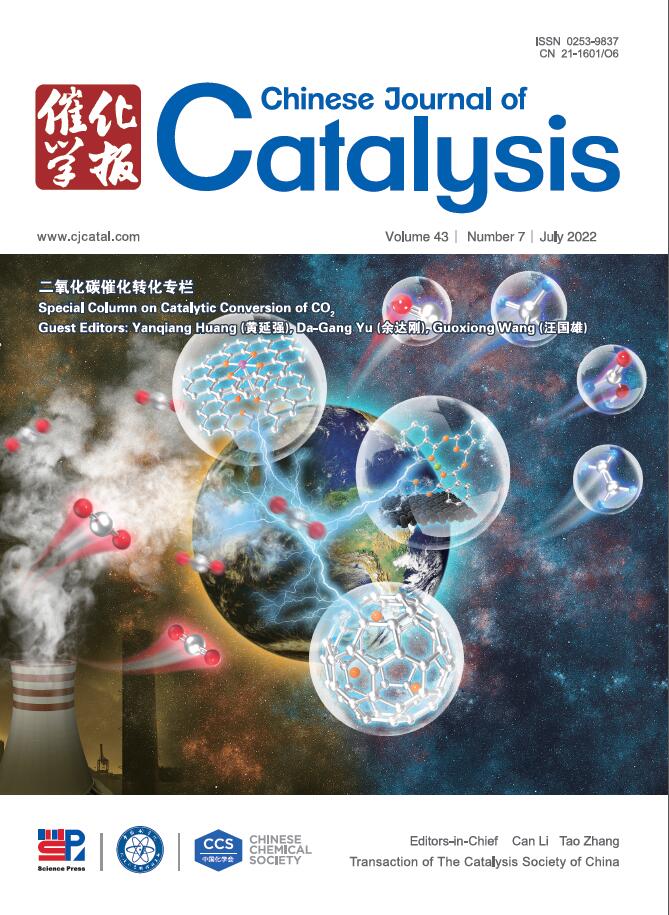Dimethoxymethane carbonylation and disproportionation over extra-large pore zeolite ZEO-1: Reaction network and mechanism
IF 15.7
1区 化学
Q1 CHEMISTRY, APPLIED
引用次数: 0
Abstract
ABSTRACT
Methyl methoxyacetate (MMAc) and methyl formate (MF) can be produced directly by heterogeneous zeolite-catalyzed carbonylation and disproportionation of dimethoxymethane (DMM), with near 100% selectivity for each process. Despite continuous research efforts, the insight into the reaction mechanism and kinetics theory are still in their nascent stage. In this study, ZEO-1 material, a zeolite with up to now the largest cages comprising 16×16-MRs, 16×12-MRs, and 12×12-MRs, was explored for DMM carbonylation and disproportionation reactions. The rate of MMAc formation based on accessible Brönsted acid sites is 2.5 times higher for ZEO-1 (Si/Al = 21) relative to the previously investigated FAU (Si/Al = 15), indicating the positive effect of spatial separation of active sites in ZEO-1 on catalytic activity. A higher MF formation rate is also observed over ZEO-1 with lower activation energy (79.94 vs. 95.19 kJ/mol) compared with FAU (Si/Al = 30). Two types of active sites are proposed within ZEO-1 zeolite: Site 1 located in large cages formed by 16×16-MRs and 16×12-MRs, which is active predominantly for MMAc formation, and Site 2 located in smaller cages for methyl formate/dimethyl ether formation. Kinetics investigation of DMM carbonylation over ZEO-1 exhibit a first-order dependence on CO partial pressure and a slightly inverse-order dependence on DMM partial pressure. The DMM disproportionation is nearly first-order dependence on DMM partial pressure, while it reveals a strongly inverse dependence with increasing CO partial pressure. Furthermore, ZEO-1 exhibits good catalytic stability, and almost no deactivation is observed during the more than 70 h test with high carbonylation selectivity of above 89%, due to the well-enhanced diffusion property demonstrated by intelligent-gravimetric analysis.
超大孔径沸石ZEO-1上二甲氧基甲烷羰基化和歧化反应网络及机理
摘要异相沸石催化二甲氧基甲烷(DMM)羰基化和歧化反应可直接制备甲氧基乙酸甲酯(MMAc)和甲酸甲酯(MF),两种反应的选择性接近100%。尽管研究不断努力,但对反应机理和动力学理论的认识仍处于初级阶段。在本研究中,ZEO-1材料,迄今为止最大的笼状沸石,包括16×16-MRs, 16×12-MRs和12×12-MRs,探索了DMM羰基化和歧化反应。相对于先前研究的FAU (Si/Al = 15), ZEO-1 (Si/Al = 21)基于可达Brönsted酸位的MMAc形成速率高2.5倍,表明ZEO-1中活性位点的空间分离对催化活性有积极影响。与FAU (Si/Al = 30)相比,ZEO-1的MF生成速率更高,活化能(79.94 vs. 95.19 kJ/mol)更低。在ZEO-1沸石中提出了两种类型的活性位点:Site 1位于由16×16-MRs和16×12-MRs形成的大笼中,主要用于MMAc的形成,Site 2位于较小的笼中,用于甲酸甲酯/二甲醚的形成。DMM在ZEO-1上羰基化的动力学研究表明,CO分压与DMM分压呈一阶依赖关系,DMM分压与CO分压呈轻微的反阶依赖关系。DMM歧化反应与DMM分压呈一阶相关关系,与CO分压呈强烈的负相关关系。此外,ZEO-1表现出良好的催化稳定性,在超过70 h的测试中几乎没有观察到失活,羰基化选择性高达89%以上,这是由于智能重量分析表明ZEO-1具有良好的扩散性能。
本文章由计算机程序翻译,如有差异,请以英文原文为准。
求助全文
约1分钟内获得全文
求助全文
来源期刊

Chinese Journal of Catalysis
工程技术-工程:化工
CiteScore
25.80
自引率
10.30%
发文量
235
审稿时长
1.2 months
期刊介绍:
The journal covers a broad scope, encompassing new trends in catalysis for applications in energy production, environmental protection, and the preparation of materials, petroleum chemicals, and fine chemicals. It explores the scientific foundation for preparing and activating catalysts of commercial interest, emphasizing representative models.The focus includes spectroscopic methods for structural characterization, especially in situ techniques, as well as new theoretical methods with practical impact in catalysis and catalytic reactions.The journal delves into the relationship between homogeneous and heterogeneous catalysis and includes theoretical studies on the structure and reactivity of catalysts.Additionally, contributions on photocatalysis, biocatalysis, surface science, and catalysis-related chemical kinetics are welcomed.
 求助内容:
求助内容: 应助结果提醒方式:
应助结果提醒方式:


